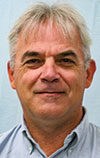Lameness can affect anywhere between 8% to 55% of dairy cows worldwide. The contributing causes of lameness are poor cow comfort, long standing time, heat stress, poor stockmanship and poor flooring.
When analyzing lameness that is caused by the walking or standing surfaces, like slippery floors with insufficient grooving and poorly done cobblestone finishing, we observe the following claw horn lesions:
- White-line lesions caused by trauma from slipping
- Sole ulcers caused from slipping and causing sole overgrowth
- Toe ulcers caused by slipping and pushing at headlock or from aggressive recycled sand
- Upper leg injuries caused by slips and falls
A flooring surface with exposed aggregate (sand and gravel), rough finish or aggressive grooving increases sole horn wear beyond the normal monthly horn production. This results in thin soles and toe ulcers. It is the worst on large farms with coarse recycled sand.
Various factors contribute to a flooring surface with good traction, including concrete floor surface, bedding type used, manure removal system and facility layout. Here is how to provide a proper and secure walking surface for cows to utilize for a long time. This guideline and specifications described below are recommended to create a quality concrete floor.
Sub-base preparation
The first line of defense for a concrete floor that will have minimal cracking is to prepare the sub-base below the concrete floor. The sub-base should be compacted in layers less than 6 inches thick at a time. The concrete slab is placed on top of this compacted sub-base at the correct elevation, slope and thickness that the design requires.
Concrete mix specifications
The main ingredients in concrete are Portland cement and water to create a paste that surrounds quality aggregates. The amount of water in concrete controls many fresh and hardened properties in concrete including workability, compressive strengths, permeability and watertightness, durability and weathering, drying shrinkage and potential for cracking. Air entrained in the concrete mix provides freeze protection for the concrete. The water-cement ratio specification creates the strength desired. Quality concrete in a floor requires a maximum water-cement ratio of 0.45 part water to 1 part cement. This amount of water is required for hydration. Any additional water beyond what is needed for hydration causes a loss of strength. This is a critical value that the concrete plant specifies for the mix.
When extra water is added at the plant or in the field to make it easier for the concrete to be placed, the final mix has a lower strength than purchased. Adding 1 gallon of water per cubic yard decreases compressive strength 150 to 200 pounds per square inch (psi), wastes about one-fourth bag of cement and increases shrinkage by 10% (Figure 1).

Placing concrete
Concrete is placed, not poured. Pouring implies that the concrete flows. If concrete flows, it likely means there is too much water in the mix. The money spent for the strength and quality purchased at the concrete plant is lost. A properly placed flat floor requires several people and the right equipment. Vibrating screeds or slip-formed concrete slabs use machinery rather than people to place the concrete properly.
Finishing concrete
Concrete floor finish for cows is a compromise to provide sure-footed surface with enough traction that also does not cause too much wear on the cows' hooves when walking. The first goal is to create a flat walking surface with a light float finish.
Grooving concrete
The second goal is to provide sharp-edged grooves for the hooves to create the traction required to prevent the cow from slipping. Normal healthy hooves perform best on a completely flat floor with grooves that have 90-degree edges and are 0.75-inch wide by 0.5-inch deep spaced at 3.25 inches on center, which leaves 2.5 inches of flat surface between the grooves (Figure 2). It is recommended to cut grooves into new flat concrete. It is the most efficient to cut grooves between seven to 12 days after the concrete is placed. Waiting longer makes the concrete harder and slows the cutting of the grooves.

The proper groove finish has provided the best overall result when analyzing farm records. This is a widely-used floor pattern worldwide in new dairy facilities today. When the walking surface is completely flat, with appropriate grooves going in the direction of the main traffic, cows will have the best mobility. When cows have good mobility and are confident walking, it results in good estrus cycles, fewer upper leg injuries, better stride length and lower lameness (Figure 3).

Grooves made with a bull float at the time of placing new concrete will never provide as sharp of an edge in comparison to cutting the grooves. Some contractors use a V-shaped bull float to place grooves into wet concrete. This does not create a sharp 90-degree edge. In the long term, it results in more slips and an increase in lameness.
Curing concrete
Concrete sets and hardens because of hydration which is a chemical reaction between the cementitious materials and water. Curing requires maintaining satisfactory temperature and moisture conditions in the concrete long enough for hydration to develop the desired concrete properties. Many concrete floors are not cured properly because it requires extra effort and time. Quality concrete flatwork requires proper wet curing for a minimum of seven days, achieving 65% of its design strength in that time (Figure 1). Concrete that is not wet cured dries too rapidly and reaches less than half its potential strength. It will also have a greater number of shrinkage cracks.
Concrete floors in dairy facilities can fail for many reasons. If any one of the guidelines and specifications above are ignored or compromised, the probability increases that the floor will not provide a confident walking surface in the short term, and it will not last as long as it could have. We have learned that lameness related to floors or walking surfaces appears to happen over and over again. In many cases, cows become lame and stay lame, resulting in a decrease in productivity and longevity.
Who is responsible for getting it done right? Of course, the dairy producer is responsible, but they often do not have the time during the project to oversee the contractor and trust they will do the job right. In addition, there are some cases where they are not willing to pay the extra cost to ensure the process is managed appropriately.
Ultimately, the final flooring surface for confident footing starts with the correct concrete mix. The finish should be completely flat with sharp-edged grooves spaced at the proper spacing. Superior flooring allows cows to walk with a longer and more confident stride. Better estrus signs and fewer upper leg injuries are also a result. There is a great reduction of the common claw horn lesion. All of this results in increased cow longevity and higher lifetime milk production.








